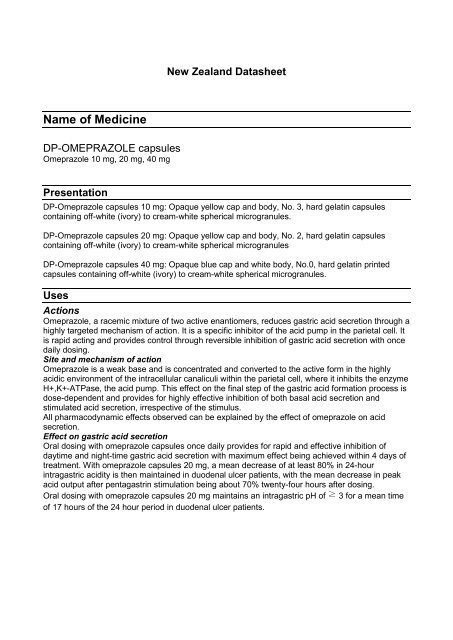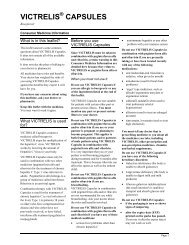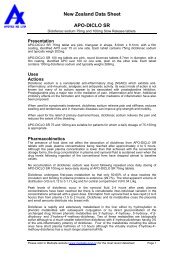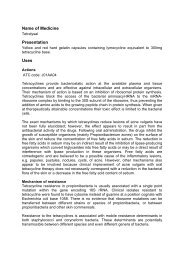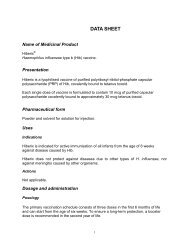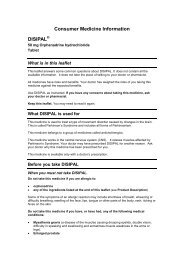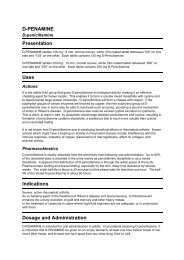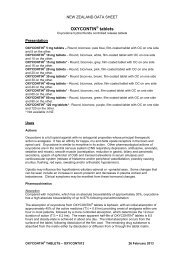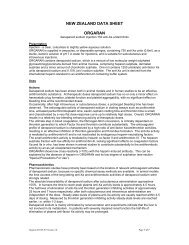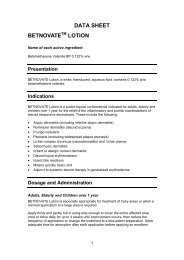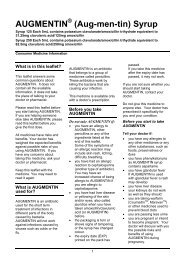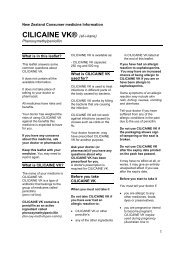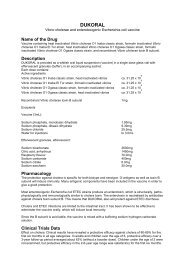Name of Medicine - Medsafe
Name of Medicine - Medsafe
Name of Medicine - Medsafe
You also want an ePaper? Increase the reach of your titles
YUMPU automatically turns print PDFs into web optimized ePapers that Google loves.
<strong>Name</strong> <strong>of</strong> <strong>Medicine</strong><br />
DP-OMEPRAZOLE capsules<br />
Omeprazole 10 mg, 20 mg, 40 mg<br />
Presentation<br />
New Zealand Datasheet<br />
DP-Omeprazole capsules 10 mg: Opaque yellow cap and body, No. 3, hard gelatin capsules<br />
containing <strong>of</strong>f-white (ivory) to cream-white spherical microgranules.<br />
DP-Omeprazole capsules 20 mg: Opaque yellow cap and body, No. 2, hard gelatin capsules<br />
containing <strong>of</strong>f-white (ivory) to cream-white spherical microgranules<br />
DP-Omeprazole capsules 40 mg: Opaque blue cap and white body, No.0, hard gelatin printed<br />
capsules containing <strong>of</strong>f-white (ivory) to cream-white spherical microgranules.<br />
Uses<br />
Actions<br />
Omeprazole, a racemic mixture <strong>of</strong> two active enantiomers, reduces gastric acid secretion through a<br />
highly targeted mechanism <strong>of</strong> action. It is a specific inhibitor <strong>of</strong> the acid pump in the parietal cell. It<br />
is rapid acting and provides control through reversible inhibition <strong>of</strong> gastric acid secretion with once<br />
daily dosing.<br />
Site and mechanism <strong>of</strong> action<br />
Omeprazole is a weak base and is concentrated and converted to the active form in the highly<br />
acidic environment <strong>of</strong> the intracellular canaliculi within the parietal cell, where it inhibits the enzyme<br />
H+,K+-ATPase, the acid pump. This effect on the final step <strong>of</strong> the gastric acid formation process is<br />
dose-dependent and provides for highly effective inhibition <strong>of</strong> both basal acid secretion and<br />
stimulated acid secretion, irrespective <strong>of</strong> the stimulus.<br />
All pharmacodynamic effects observed can be explained by the effect <strong>of</strong> omeprazole on acid<br />
secretion.<br />
Effect on gastric acid secretion<br />
Oral dosing with omeprazole capsules once daily provides for rapid and effective inhibition <strong>of</strong><br />
daytime and night-time gastric acid secretion with maximum effect being achieved within 4 days <strong>of</strong><br />
treatment. With omeprazole capsules 20 mg, a mean decrease <strong>of</strong> at least 80% in 24-hour<br />
intragastric acidity is then maintained in duodenal ulcer patients, with the mean decrease in peak<br />
acid output after pentagastrin stimulation being about 70% twenty-four hours after dosing.<br />
Oral dosing with omeprazole capsules 20 mg maintains an intragastric pH <strong>of</strong> � 3 for a mean time<br />
<strong>of</strong> 17 hours <strong>of</strong> the 24 hour period in duodenal ulcer patients.
As a consequence <strong>of</strong> reduced acid secretion and intragastric acidity, omeprazole dosedependently<br />
reduces/normalises acid exposure <strong>of</strong> the oesophagus in patients with gastrooesophageal<br />
reflux disease.<br />
The inhibition <strong>of</strong> acid secretion is related to the area under the plasma concentration-time curve<br />
(AUC) <strong>of</strong> omeprazole and not to the actual plasma concentration at a given time.<br />
No tachyphylaxis has been observed during treatment with omeprazole.<br />
Effect on Helicobacter pylori<br />
Helicobacter pylori is associated with acid peptic disease, including duodenal and gastric ulcer<br />
disease, in which about 95% and 70% <strong>of</strong> patients respectively are infected with this bacterium.<br />
H.pylori is a major factor in the development <strong>of</strong> gastritis. H.pylori together with gastric acid are<br />
major factors in the development <strong>of</strong> peptic ulcer disease. H.pylori has been found to play a causal<br />
role in the development <strong>of</strong> gastric carcinoma.<br />
Omeprazole has a bactericidal effect on H.pylori in vitro.<br />
Eradication <strong>of</strong> H.pylori with omeprazole and antimicrobials is associated with rapid symptom relief,<br />
high rates <strong>of</strong> healing <strong>of</strong> any mucosal lesions, and long-term remission <strong>of</strong> peptic ulcer disease thus<br />
reducing complications such as gastrointestinal bleeding as well as the need for prolonged antisecretory<br />
treatment.<br />
Other effects related to acid inhibition<br />
During long-term treatment gastric glandular cysts have been reported in a somewhat increased<br />
frequency. These changes are a physiological consequence <strong>of</strong> pronounced inhibition <strong>of</strong> acid<br />
secretion, are benign and appear to be reversible.<br />
Decreased gastric acidity due to any means including proton pump inhibitors, increases gastric<br />
counts <strong>of</strong> bacteria normally present in the gastrointestinal tract. Treatment with acid-reducing drugs<br />
may lead to slightly increased risk <strong>of</strong> gastrointestinal infections such as Salmonella and<br />
Campylobacter.<br />
Pharmacokinetics<br />
Absorption and distribution<br />
Omeprazole is acid labile and is therefore administered orally as enteric-coated pellets in capsules<br />
or tablets.<br />
Absorption <strong>of</strong> omeprazole takes place in the small intestine and is usually completed within 3-6<br />
hours. The systemic bioavailability <strong>of</strong> omeprazole from a single oral dose <strong>of</strong> omeprazole capsules<br />
is approximately 35%. After repeated once daily administration, the bioavailability increases to<br />
about 60%. The apparent volume <strong>of</strong> distribution in healthy subjects is approximately 0.3 L/kg and a<br />
similar value is also seen in patients with renal insufficiency. In elderly patients, and in patients with<br />
hepatic insufficiency, the volume <strong>of</strong> distribution is slightly decreased. Concomitant intake <strong>of</strong> food<br />
has no influence on the bioavailability. The plasma protein binding <strong>of</strong> omeprazole is about 95%.<br />
Metabolism and excretion<br />
After oral administration, the plasma elimination half-life <strong>of</strong> omeprazole is usually shorter than one<br />
hour and there is no change in half-life during long-term treatment.
Omeprazole is completely metabolised by the cytochrome P450 system (CYP), mainly in the liver.<br />
The major part <strong>of</strong> its metabolism is dependent on the polymorphically expressed, specific is<strong>of</strong>orm<br />
CYP2C19 (S-mephenytoin hydroxylase), responsible for the formation <strong>of</strong> hydroxyomeprazole, the<br />
major metabolite in plasma. In accordance with this, as a consequence <strong>of</strong> competitive inhibition,<br />
there is a potential for metabolic drug-drug interactions between omeprazole and other substrates<br />
for CYP2C19.<br />
No metabolite has been found to have any effect on gastric acid secretion. Almost 80% <strong>of</strong> an orally<br />
given dose is excreted as metabolites in the urine, and the remainder is found in the faeces,<br />
primarily originating from bile secretion.<br />
The systemic bioavailability and elimination <strong>of</strong> omeprazole is unchanged in patients with reduced<br />
renal function. The area under the plasma concentration-time curve, and the elimination half-life<br />
are increased in patients with impaired liver function, but omeprazole has not shown any tendency<br />
to accumulate with once daily dosing.<br />
Children<br />
Available data from children (1 year and older) suggests that the pharmacokinetics, within the<br />
recommended dosages (see Dosage and Administration) is similar to those reported in adults.<br />
Indications<br />
DP-Omeprazole capsules are indicated for the treatment <strong>of</strong>:<br />
• reflux oesophagitis<br />
• duodenal ulcer<br />
• gastric ulcer<br />
• NSAID-associated gastric and duodenal ulcers or erosions<br />
• Acid related dyspepsia<br />
• Zollinger-Ellison syndrome.<br />
In the treatment <strong>of</strong> peptic ulceration, the eradication <strong>of</strong> H.pylori, as the causative organism, must<br />
be a high priority.<br />
Accordingly, omeprazole capsules should be used as part <strong>of</strong> combination therapy for the<br />
eradication <strong>of</strong> H.pylori.<br />
Maintenance<br />
DP-Omeprazole capsules are indicated for maintenance treatment <strong>of</strong>:<br />
• reflux oesophagitis<br />
• duodenal ulcer<br />
• gastric ulcer<br />
• Zollinger-Ellison syndrome.<br />
Dosage and Administration<br />
DP-Omeprazole capsules are recommended to be given in the morning and swallowed whole with<br />
half a glass <strong>of</strong> water. The contents <strong>of</strong> the capsule should not be chewed or crushed.<br />
For patients with swallowing difficulties and for children who can drink or swallow semisolid<br />
food<br />
For patients with swallowing difficulties the capsule can be opened and the contents swallowed<br />
directly with half a glass <strong>of</strong> liquid or after mixing the contents in a slightly acidic fluid e.g. fruit juice,<br />
yoghurt or in non carbonated water. The dispersion should be taken immediately or within 30<br />
minutes. Alternatively patients can suck the
capsule and swallow the pellets with liquid. The pellets must not be chewed or crushed.<br />
Reflux oesophagitis<br />
The recommended dosage is DP-Omeprazole capsules 20 mg once daily. Symptom resolution is<br />
rapid and in most patients healing occurs within 4 weeks. For those patients who may not be fully<br />
healed after the initial course, healing usually occurs during a further 4 weeks' treatment period.<br />
In patients with severe reflux oesophagitis 40 mg once daily is recommended and healing is<br />
usually achieved within 8 weeks.<br />
For the long-term management <strong>of</strong> patients with healed reflux oesophagitis the recommended dose<br />
is 10 mg once daily. If needed the dose can be increased to 20-40 mg once daily.<br />
Severe reflux oesophagitis in children from one year and older<br />
The management <strong>of</strong> severe reflux<br />
oesophagitis should be diagnosed or<br />
recommended by a specialist paediatrician or<br />
gastroenterologist. The recommended dosage<br />
regime for healing is:<br />
Weight Dosage<br />
10-20 kg 10 mg daily<br />
> 20 kg 20 mg daily<br />
If needed dosage may be increased to 20 mg and 40 mg respectively.<br />
Helicobacter pylori (Hp) eradication regimens in peptic ulcer disease<br />
Triple therapy regimens<br />
DP-Omeprazole capsules 20 mg, amoxicillin 1 g and clarithromycin 500 mg, all twice a day for one<br />
week<br />
or<br />
DP-Omeprazole capsules 20 mg, clarithromycin 250 mg and metronidazole 400 mg (or tinidazole<br />
500 mg), all twice a day for one week<br />
or<br />
DP-Omeprazole capsules 40 mg once daily with amoxicillin 500 mg and metronidazole 400 mg<br />
both three times a day for one week.<br />
Dual therapy regimens<br />
DP-Omeprazole capsules 40-80 mg daily with amoxicillin 1.5 g daily in divided doses for two<br />
weeks. In clinical studies daily doses <strong>of</strong> 1.5-3 g <strong>of</strong> amoxicillin have been used<br />
or<br />
DP-Omeprazole capsules 40 mg once daily and clarithromycin 500 mg three times a day for two<br />
weeks.<br />
To ensure healing in patients with active peptic ulcer disease, see further dosage<br />
recommendations for duodenal and gastric ulcer.<br />
In each regimen if the patient is still Hp positive, therapy may be repeated.<br />
Duodenal ulcer<br />
The recommended dosage in patients with an active duodenal ulcer is DP-Omeprazole capsules<br />
20 mg once daily. Symptom resolution is rapid and in most patients healing.<br />
Gastric ulcer<br />
The recommended dosage is DP-Omeprazole capsules 20 mg once daily. Symptom resolution is<br />
rapid and in most patients healing occurs within 4 weeks. For those patients who may not be fully<br />
healed after the initial course, healing usually occurs during a further 4 weeks' treatment period.<br />
In patients with poorly responsive gastric ulcer 40 mg once daily is recommended and healing is<br />
usually achieved within 8 weeks.<br />
For the prevention <strong>of</strong> relapse in patients with poorly responsive gastric ulcer the recommended<br />
dose is 20 mg once daily. If needed, the dose can be increased to 40 mg once daily.
For NSAID-associated gastric ulcers see "NSAID-Associated Gastroduodenal Lesions".<br />
NSAID-associated gastroduodenal lesions<br />
For NSAID-associated gastric ulcers, duodenal ulcers or gastroduodenal erosions in patients with<br />
or without continued NSAID treatment, the recommended dosage <strong>of</strong> DP-Omeprazole capsules is<br />
20 mg once daily. Symptom resolution is rapid and in most patients healing occurs within 4 weeks.<br />
For those patients who may not be fully healed after the initial course, healing usually occurs<br />
during a further 4 weeks treatment period.<br />
For the prevention <strong>of</strong> NSAID-associated gastric ulcers, duodenal ulcers, gastroduodenal erosions<br />
and dyspeptic symptoms the recommended dosage is 20 mg once daily.<br />
Symptoms <strong>of</strong> Acid-related dyspepsia<br />
For the 24-hour relief, and prevention <strong>of</strong> symptoms in patients with epigastric pain/discomfort with<br />
or without heartburn and indigestion, 20 mg once daily in the morning for 14 –28 days*. If symptom<br />
control has not been achieved after 4 weeks treatment with 20 mg daily, further investigation is<br />
recommended.<br />
*Patients may respond adequately to 10 mg daily and this dose could be considered as a starting<br />
dose.<br />
Zollinger-Ellison syndrome<br />
In patients with Zollinger-Ellison syndrome the dosage should be individually adjusted and<br />
treatment continued as long as is clinically indicated. The recommended initial dosage is Dp-<br />
Omeprazole capsules 60 mg daily. All patients with severe disease and inadequate response to<br />
other therapies have been effectively controlled and more than 90% <strong>of</strong> the patients maintained on<br />
doses <strong>of</strong> 20-120 mg daily. When doses exceed 80 mg daily, the dose should be divided and given<br />
twice daily.<br />
Impaired Renal Function<br />
Dose adjustment is not needed in patients with impaired renal function.<br />
Impaired Hepatic Function<br />
As bioavailability and plasma half-life <strong>of</strong> omeprazole are increased in patients with impaired hepatic<br />
function a daily dose <strong>of</strong> 10 - 20 mg may be sufficient.<br />
Elderly<br />
Dose adjustment is not needed in the elderly.<br />
Contraindications<br />
Known hypersensitivity to omeprazole<br />
Warnings and Precautions<br />
In the presence <strong>of</strong> any alarm symptom (e.g. significant unintentional weight loss, recurrent<br />
vomiting, dysphagia, haematemesis or melena) and when gastric ulcer is suspected or present, the<br />
possibility <strong>of</strong> malignancy should be excluded as treatment may alleviate symptoms and delay<br />
diagnosis.
Use in Pregnancy and Lactation<br />
Results from three prospective epidemiological studies indicate no adverse effects <strong>of</strong> omeprazole<br />
on pregnancy or on the health <strong>of</strong> the foetus/newborn child. DP-Omeprazole capsules can be used<br />
during pregnancy.<br />
Omeprazole is excreted in breast milk but is not likely to influence the child when therapeutic doses<br />
are used.<br />
Effects on Ability to Drive and Use Machines<br />
DP-Omeprazole capsules are not likely to affect the ability to drive or use machines.<br />
Adverse Effects<br />
Omeprazole capsules are well tolerated and adverse reactions have generally been mild and<br />
reversible. The following events have been reported as adverse events in clinical trials or reported<br />
from routine use, but in many cases a relationship to treatment with omeprazole has not been<br />
established.<br />
The following definitions <strong>of</strong> frequencies are used:<br />
Common<br />
≥1/100<br />
Uncommon ≥1/1,000 and<br />
Interactions<br />
Gastrointestinal: Dry mouth, stomatitis and<br />
gastrointestinal candidiasis<br />
Haematological: Leukopenia, thrombocytopenia,<br />
agranulocytosis and pancytopenia.<br />
Hepatic: Encephalopathy in patients with preexisting<br />
severe liver disease; hepatitis<br />
with or without jaundice, hepatic failure<br />
Musculoskeletal: Arthralgia, muscular weakness and<br />
myalgia<br />
Skin: Photosensitivity, erythema multiforme,<br />
Stevens-Johnson syndrome, toxic<br />
epidermal necrolysis (TEN), alopecia<br />
Hypersensitivity reactions eg.<br />
angioedema, fever, bronchospasm,<br />
interstitial nephritis and anaphylactic<br />
shock.<br />
Other: Increased sweating, peripheral oedema,<br />
blurred vision, taste disturbance and<br />
hyponatraemia.<br />
The absorption <strong>of</strong> some medicines might be altered due to the decreased intragastric acidity. The<br />
absorption <strong>of</strong> ketoconazole and itraconazole can decrease during omeprazole treatment, as it does<br />
during treatment with other acid secretion inhibitors or antacids.<br />
No interaction with food or concomitantly administered antacids has been found.<br />
As omeprazole is metabolised in the liver through cytochrome P450 2C19 (CYP2C19), it can<br />
prolong the elimination <strong>of</strong> diazepam, phenytoin, warfarin (R-warfarin) and other vitamin K<br />
antagonists which are all in part substrates for this enzyme.<br />
Monitoring <strong>of</strong> patients receiving phenytoin is recommended and a reduction <strong>of</strong> phenytoin dose may<br />
be necessary. However concomitant treatment with omeprazole capsules 20 mg daily did not<br />
change the blood concentration <strong>of</strong> phenytoin in patients on continuous treatment with this<br />
medicine. In patients receiving warfarin or other vitamin K antagonists, monitoring <strong>of</strong> INR is<br />
recommended and a reduction <strong>of</strong> the warfarin (or other vitamin K antagonist) dose may be<br />
necessary. Concomitant treatment with omeprazole capsules 20 mg daily did, however, not<br />
change coagulation time in patients on continuous treatment with warfarin.<br />
Plasma concentrations <strong>of</strong> omeprazole and clarithromycin are increased during concomitant<br />
administration but there is no interaction with metronidazole or amoxicillin. These antimicrobials<br />
are used together with omeprazole for eradication <strong>of</strong> Helicobacter pylori.<br />
Concomitant administration <strong>of</strong> omeprazole has been reported to reduce the plasma levels <strong>of</strong><br />
atazanavir.<br />
Concomitant administration <strong>of</strong> omeprazole and tacrolimus may increase the serum levels <strong>of</strong><br />
tacrolimus.<br />
Concomitant administration <strong>of</strong> omeprazole and a CYP2C19 and CYP3A4 inhibitor, voriconazole,<br />
resulted in more than doubling <strong>of</strong> the omeprazole exposure. However, a dose adjustment <strong>of</strong><br />
omeprazole was not required.<br />
Results from a range <strong>of</strong> interaction studies with omeprazole capsules versus other medicines<br />
indicate that omeprazole, 20-40 mg daily, has no influence on any other relevant is<strong>of</strong>orms <strong>of</strong> CYP,<br />
as shown by the lack <strong>of</strong> metabolic interaction with substrates for CYP1A2 (caffeine, phenacetin,<br />
theophylline), CYP2C9 (S-warfarin, piroxicam, dicl<strong>of</strong>enac and naproxen), CYP2D6 (metoprolol,
propranolol), CYP2E1 (ethanol), and CYP3A (cyclosporin, lidocaine, quinidine, estradiol,<br />
erythromycin, budesonide).<br />
Overdosage<br />
Rare reports have been received <strong>of</strong> overdosage with omeprazole. In the literature doses <strong>of</strong> up to<br />
560 mg have been described and occasional reports have been received when single oral doses<br />
have reached up to 2,400 mg omeprazole (120 times the usual recommended clinical dose).<br />
Nausea, vomiting, dizziness, abdominal pain, diarrhoea and headache have been reported from<br />
overdosage with omeprazole. Also apathy, depression and confusion have been described in<br />
single cases.<br />
The symptoms described in connection to omeprazole overdosage have been transient, and no<br />
serious outcome due to omeprazole has been reported. The rate <strong>of</strong> elimination was unchanged<br />
(first order kinetics) with increased doses and no specific treatment has been needed.<br />
Pharmaceutical Precautions<br />
Store below 25ºC.<br />
Capsules in HDPE bottles: Use within 3 months <strong>of</strong> opening.<br />
<strong>Medicine</strong> Classification<br />
Prescription <strong>Medicine</strong><br />
Package Quantities<br />
10 mg: Cartons <strong>of</strong> aluminium blisters containing 7, 14, 15, 28, 30, 50, 56, 60, 90, 98, 100, 140 and<br />
280 capsules. HDPE bottles <strong>of</strong> 5, 30, 50, 56, 60, 90, 100 capsules<br />
20 mg: Cartons <strong>of</strong> aluminium blisters containing 7, 14, 15, 28, 30, 50, 56, 60, 90, 98, 100, 140, 280<br />
and 500 capsules. HDPE bottles <strong>of</strong> 5, 7, 14, 15, 28, 30, 50, 56, 60, 90, 100 capsules<br />
40 mg: Cartons <strong>of</strong> aluminium blisters containing 7, 14, 15, 28, 30, 50, 56, 60, 90, 98, 100, 140,<br />
280, 500 capsules. HDPE bottles <strong>of</strong> 5, 7, 14, 15, 28, 30, 50, 56, 60, 90, 100 capsules<br />
Not all pack sizes may be marketed.<br />
Preclinical safety data<br />
Gastric ECL-cell hyperplasia and carcinoids, have been observed in life-long studies in rats treated<br />
with omeprazole. These changes are the result <strong>of</strong> sustained hypergastrinaemia secondary to acid<br />
inhibition. Similar findings have been made after treatment with H2-receptor antagonists, proton<br />
pump inhibitors and after partial fundectomy. Thus, these changes are not from a direct effect <strong>of</strong><br />
any individual drug.<br />
<strong>Name</strong> and Address<br />
Douglas Pharmaceuticals Limited<br />
P O Box 45 027,<br />
Te Atatu Peninsula
Auckland 0651<br />
Ph: (09)835 0660<br />
Date <strong>of</strong> Preparation<br />
February 2011


